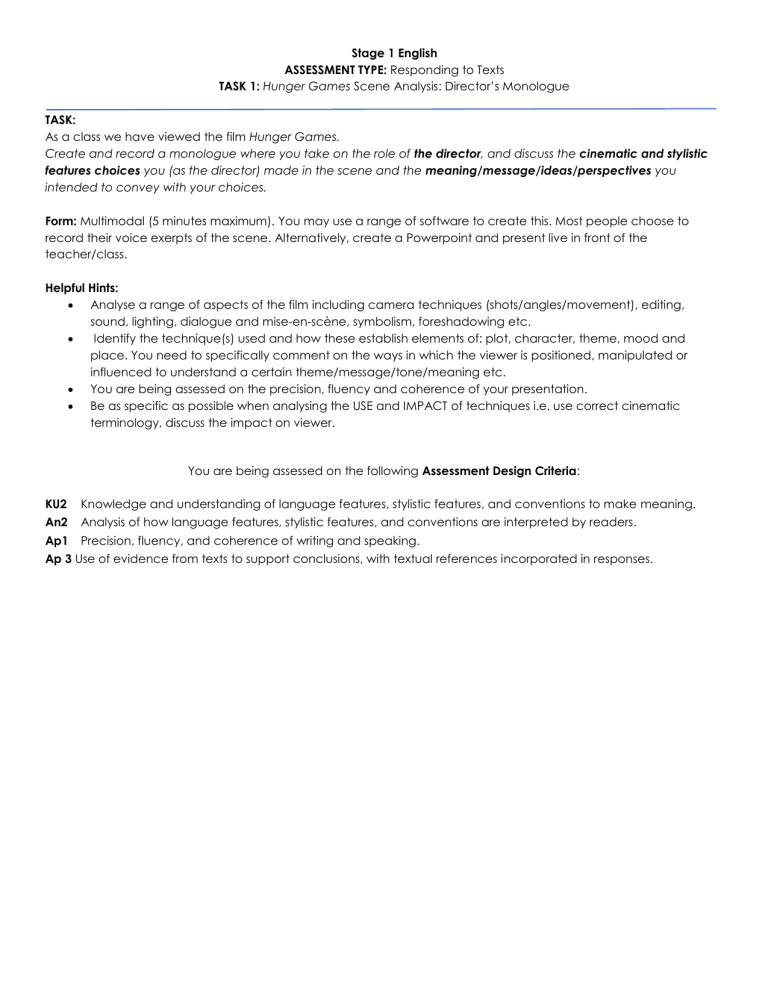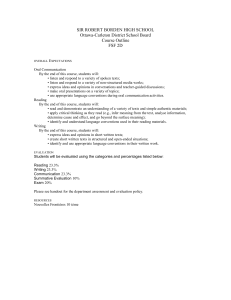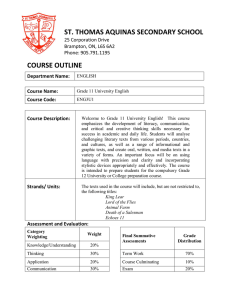
Stage 1 English ASSESSMENT TYPE: Responding to Texts TASK 1: Hunger Games Scene Analysis: Director’s Monologue TASK: As a class we have viewed the film Hunger Games. Create and record a monologue where you take on the role of the director, and discuss the cinematic and stylistic features choices you (as the director) made in the scene and the meaning/message/ideas/perspectives you intended to convey with your choices. Form: Multimodal (5 minutes maximum). You may use a range of software to create this. Most people choose to record their voice exerpts of the scene. Alternatively, create a Powerpoint and present live in front of the teacher/class. Helpful Hints: Analyse a range of aspects of the film including camera techniques (shots/angles/movement), editing, sound, lighting, dialogue and mise-en-scène, symbolism, foreshadowing etc. Identify the technique(s) used and how these establish elements of: plot, character, theme, mood and place. You need to specifically comment on the ways in which the viewer is positioned, manipulated or influenced to understand a certain theme/message/tone/meaning etc. You are being assessed on the precision, fluency and coherence of your presentation. Be as specific as possible when analysing the USE and IMPACT of techniques i.e. use correct cinematic terminology, discuss the impact on viewer. You are being assessed on the following Assessment Design Criteria: KU2 Knowledge and understanding of language features, stylistic features, and conventions to make meaning. An2 Analysis of how language features, stylistic features, and conventions are interpreted by readers. Ap1 Precision, fluency, and coherence of writing and speaking. Ap 3 Use of evidence from texts to support conclusions, with textual references incorporated in responses. A Knowledge and Understanding Analysis Application Detailed knowledge and understanding of ideas and perspectives explored in a diverse range of texts. Perceptive evaluation of the complex relationship between purpose, audience, and context and how they shape meaning. Fluent and precise writing and speaking. Extensive knowledge and understanding of the variety of language features, stylistic features, and conventions authors use to make meaning. Comprehensive knowledge and understanding of ways in which texts are created for a range of purposes and audiences. B Knowledge and understanding of ideas and perspectives explored in a range of texts. Knowledge and understanding of a range of language features, stylistic features, and conventions authors use to make meaning. Knowledge and understanding of ways in which texts are created for a range of purposes and audiences. C Knowledge and understanding of ideas and some perspectives explored in a range of texts. Knowledge and understanding of some language features, stylistic features, and conventions authors use to make meaning. Knowledge and understanding of ways in which texts are created for familiar purposes and audiences. D Reference to simple ideas explored in texts. Knowledge and understanding of a narrow range of language features and conventions authors use to make meaning. Knowledge and understanding of a restricted range of ways in which texts are created for limited purposes and audiences. E Identification of an idea in a text. Recognition of a restricted range of language features used by authors. Acknowledgment of one or more ways in which texts are created for a purpose or an audience. Insightful analysis of how language features, stylistic features, and conventions combine to influence readers in various text types. Analysis of complex intertextual connections between different texts. Effective analysis of the relationship between purpose, audience, and context and how they shape meaning. Analysis of how language features, stylistic features, and conventions influence readers in various text types. Analysis of intertextual connections between different texts. Description, with some analysis of purpose, audience, and context and how they shape meaning. Description, with some analysis, of how language features, stylistic features, and conventions influence readers in some text types. Description, with some analysis of intertextual connections between different texts. Identification of the purpose, audience, and context of texts. Reference to some ways in which conventions and language features influence readers in some text types. Sophisticated use of appropriate language features, stylistic features, and conventions for a range of audiences and purposes. Detailed and appropriate use of evidence from texts to support conclusions, with textual references integrated into responses. Mostly fluent and precise writing and speaking. Use of accurate language features, stylistic features, and conventions for a range of audiences and purposes. Accurate use of evidence from texts to support conclusions, with textual references incorporated fluently in responses. Generally fluent and accurate writing and speaking. Use of language features, stylistic features, and conventions appropriate for familiar audiences and purposes. Use of evidence from texts to support conclusions, with some textual references incorporated in responses. Some control and fluency of expression. Use of some language features and conventions appropriate for audience and purpose. Recognition of similarities and or differences between texts. Limited use of evidence from texts to support conclusions, with limited textual references to support responses. Reference to the purpose and audience of a text. Emerging development of control of expression. Recognition of a way in which language features influence readers in a text type. Emerging use of some language features appropriate for audience and/or purpose. Recognition of a connection between texts. Restricted use of evidence from a text to support conclusions.




